#Monkfish Tail
Explore tagged Tumblr posts
Text
Lemon and Dill Monkfish
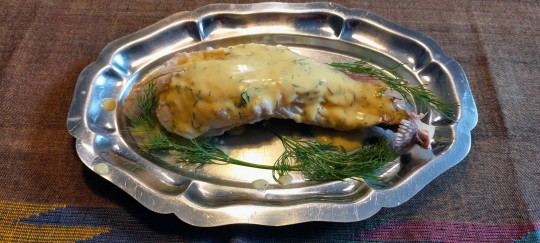
The delicate flesh of this beautiful Lemon and Dill Monkfish is beautifully fragrant with fresh herb and citrus, and generously coated in a Hollandaise blanket, making it a tasty lunch! Happy Friday!
Ingredients (serves 3):
half a large lemon
4 fluffy sprigs Garden Dill + more for garnish
2 litres/8 cups water
1 1/2 teaspoon coarse sea salt
1/2 teaspoon freshly cracked black pepper
1/2 cup dry white wine (like Sauvignon Blanc)
a beautiful (about 395-gram/14-ounce) fresh monkfish tail
Dill and Schnapps Hollandaise, warmed, to serve
Cut lemon into slices, and add lemon slices to a large, deep skillet, wide enough to fit the fish. Add Dill sprigs and cover with the water.
Bring to the boil over medium-high heat, and cover with a lid. Allow to boil, for about 10 to 15 minutes, so the broth is fragrant. Season with coarse sea salt and black pepper.
Then, stir in Sauvignon Blanc, and lower the monkfish tail into the fragrant bath. Poach, about 10 to 12 minutes until cooked through.
Lift monkfish tail out of its court-bouillon, and drain before sitting onto serving tray. Drizzle generously with warm Dill and Schnapps Hollandaise, and garnish with reserved Dill sprigs.
Serve Lemon and Dill Monkfish immediately, with more Dill and Schnapps Hollandaise, steamed broccoli and a glass of chilled Sauvignon Blanc or other crisp white wine.
#Recipe#Food#Lemon and Dill Monkfish#Lemon and Dill Monkfish recipe#Monkfish#Monkfish Tail#Fish#Fish and Seafood#Fish Friday#Lemon#Dill#Fresh Dill#Garden Dill#Coarse Sea Salt#Black Pepper#Water#White Wine#Dry White Wine#Sauvignon Blanc#Hollandaise Sauce#Dill Hollandaise Sauce#Hollandaise#Dill Hollandaise#Dill and Schnapps Hollandaise#Dill and Schnapps Hollandaise Sauce
5 notes
·
View notes
Photo

Seared Monkfish with Balsamic and Sun-Dried Tomatoes Recipe In this simple recipe, monkfish is pan-seared and served with a delicious sauce made of balsamic vinegar, garlic, and sun-dried tomatoes. 2 cloves garlic minced, 2 tablespoons balsamic vinegar, 1/2 teaspoon white sugar, 3 tablespoons olive oil divided, 2 tablespoons minced fresh parsley, 1 pinch salt and ground black pepper to taste, 1/3 cup sun-dried tomatoes with Italian herbs drained and chopped, 1 tablespoon sun-dried tomato oil, 1 tablespoon butter, 2 monkfish tail fillets
0 notes
Text
Talviel's Tamrielic Anniversary Banquet
In lieu of an updated jubilee cake for the 30 year TES/10 year ESO anniversary, here's a banquet menu fit for the nobility of Tamriel! Dig in!
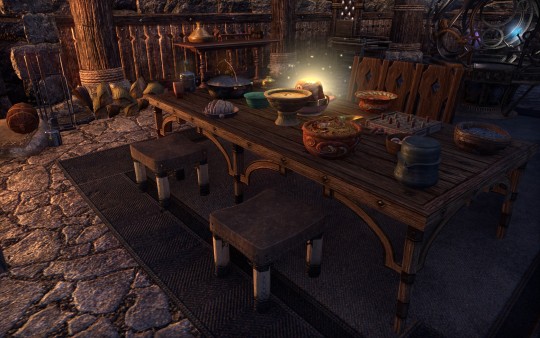
Summerset
Soft Indrik cheese and caramelised onion and pear chutney vol-au-vents, with sundried tomatoes
Auridon Blue Monkfish, poached in Russafeld Heights chardonnay
Shimmerene cherry blossom snowskin mooncake, with an apricot mousse and lemon crème filling
Black Marsh
Crocodile dumplings, with a spicy peanut and sweet saltrice dipping sauce
Stormhold jerk kagouti haunch, with guar fat vegetable fried rice
"Kueh cendol" chewy tapioca rice cakes, with dark palm sugar and coconut milk and jelly layers. A Black Marsh specialty!
Valenwood
Wild venison Greenshade carpaccio, with whipped bacon-honey butter
Stone-baked timber mammoth tail, slow roasted for 48 hours with a honey and mammoth butter glaze
Frozen honeyed "bingsoo" yoghurt, with sweetgnats, candied bacon, and deep fried lard bits, drizzled with sweet condensed milk
High Rock
Alcaire smoked pea soup, with bacon lardons and fresh garden herbs
Flambéed foie gras à la Shornhelm, with a blood orange and goose fat reduction
Gorapple tarte tatin, with golden butterscotch sauce and Bantha vanilla bean ice cream
Morrowind
Smoked kwama egg yolk carbonara, with scrib bacon
Spicy Ashlander-style shalk and ash yam stew, served in a shalk carapace
"Baked Vvardenfell" guar milk ice cream and kwama meringue cake, flavoured with comberries and gold kanet flowers
Elsweyr
Old Anequina jerboa and "lap cheong" sausage pie, with a saffron rice and an ale-and-moon sugar gravy
Terror bird egg "foo yong hai" omelette, with an array of Pellitine seafood and a bhut jolokia moon sugar caramel dipping sauce
Frozen samar pekoe tea custard, with hot moon sugar fudge
Cyrodiil
Bruma barley soup, with homemade herbed sourdough foccacia
Barbecued Blackwood cavy, basted with a rich Surilie Brothers port and habanero barbecue sauce
Abecean sea salt, dark chocolate, and Cyrodiilic olive oil ice cream, with wild strawberry coulis
Skyrim
Markarth goat cheese and pine nut crème tartlets, with smoked juniper salt
Lake Honrich salmon steak, hot smoked over maple wood with Goldenglow honey, served with dill remoulade
Snowberry panna cotta, with spiced Whiterun apple-akevitt compote
Wrothgar
Echatere Gruyère and rosemary mini soufflés, with smoked Vorkhiposh roe
Echalette steak, served medium-rare, in a ginger wine jus
Kurog's wild berry chocolate gateaux, with whipped echatere cream and drenched in wrathberry brandy
Hammerfell
Port Hunding roasted red pepper and harissa hummus, with spiced lentil flatbreads
Spicy Alik'r giant snake tikka, with mint yoghurt dipping sauce and pickles
Coconut and medjool date kulfi, with a slice of rosewater and pistachio baklava
112 notes
·
View notes
Text

Between 100-130 million years ago on Atterra, lophiiformes (anglerfish) split off from other teleost fish and began diversifying much like their Earth counterparts. During this period, a group of early anglerfish began to crawl along the ocean floor, just like the extant frogfish of Earth. This lineage of anglers found their way into the hollows through flooded or underwater tunnels. Slowly transitioning from salt water to brackish waters before finally becoming freshwater fish as they adapted to their new environment. These underground anglers began to use their diminishing swim bladder as a basic lung as they clumsily walked across the cavern’s floor in search of new hunting grounds and/or water sources to breed. Each new generation of these amphibious anglers became increasingly efficient at terrestrial locomotion. As time passed, the rays of the amphibious angler’s fins fused to resemble tetrapod limbs. This adaptation allowed them greater survivability from predation by anthropods (arthropods that diverged early in their evolution, developing an internal skeleton, lungs, and a closed circulatory system). Enabling them to diversify into different niches.
As their limbs became more specialized for movement on land, the terrestrial anglerfish split into three distinct lineages found in the second and third layers of the hollows. The more basal ambush predators who continued to live a more amphibious and sedentary life stayed close to water, utilizing camouflage and their lures to hunt prey in competition with small amphibians inhabiting the hollows. Most species specialized in running down prey lost their lure entirely, filling small to medium grazers and predators niches. Those specializing in climbing and arboreal life developed long, prehensile tails to help them navigate their environment. A handful of these species have colonized Atterra’s surface to varying degrees. Due to terrestrial anglerfish having four legs instead of three like the terrestrial mudskippers, terrestrial anglers can reach larger sizes on average than terrestrial mudskippers. With the average height of many terrestrial anglerfish species being waist to chest height of most humans.
Anatomy/ Physiology:
Terrestrial anglerfish have four-chambered hearts like birds, mammals, and other terrestrial teleost fish. The hyoid bone and inner ear bones are formed from the gill arches of the terrestrial anglerfish; the gill arches ossifying and attaching to the back of the lower jaw to form the ear bones of the animal. Like terrestrial mudskippers, the terrestrial anglerfish has four nostrils, the two on the end of their snout, and the two under their back legs evolved from their gill openings, which were used in the same way as frogfish as a means of jet propulsion by gulping in water through the mouth and pushing it out through their gill openings.
Like in other terrestrial teleost fish, the gill covers form into an outer ear to help it detect sounds. Since anglerfish devour prey through suction feeding, terrestrial anglerfish adapted their jaws to hunt prey on land efficiently. An extra jawbone attached from the back of the bottom jaw and the temple (as seen in some anglerfish, such as monkfish) enables terrestrial anglerfish to extend their jaws forward in the same way sharks can. Once extended, the top jaw swings downwards to shut the jaw to grab its prey. The jaws are then retracted as the extra jawbone is pulled back into its resting position. To aid in prey capture, some terrestrial anglerfish also possess an extendable tongue like a frog or chameleon to secure prey and pull it into the animal's jaws.
Specializations:
Species that have lost their lure use their two remaining dorsal spines for display and as a signifier of their health to fellow competitors and possible mates. The aboral species of terrestrial anglers use their long prehensile tails to grip tree branches and fungal towers as a fifth limb. Some species even use their tails, like boa constrictors, to constrict their prey.
#fantasy#creature#creature art#creature design#monster design#monsters#speculative biology#speculative evolution#art#artwork#digital art#my art#illustration#drawing#digital illustration#sketch#skeleton art
22 notes
·
View notes
Text
Ough scene from Under the Surface that I really liked but unfortunately had to cut
I'll put it here though in case others want to read
We swam through the dense kelp that covered the sea floor.
I always liked this area, small snails stuck to the leaves like sticky sea foam.
They were easy to pick at and snack on when bored.
I pulled one off now, shoving a sharp thumb into the side of the shell a decent opening presented itself.
I stuck my tongue inside to slurp up the goodies.
Sun finally caught up to me.
He was doing a twisty motion in the water this time, turning his tail side to side instead of up and down.
I told him to stop bending his tail at the middle like he always did, and he took that to stop bending his tail altogether.
I was getting kind of sick of the guy so I neglected correcting him.
And also cause he looked kind of hilarious doing that.
He twisted along the seafloor, pulling himself up like some hapless slug.
‘And– what– was the point– of bringing me– all the way out here?’
He punctuated each thought with a movement, leaving a zig zagging trail behind him as he pulled himself along the seafloor.
I snorted.
At least he was building tail muscle.
‘I’m hungry. Taking a break.’
I bit down on the hard shell, cracking off another small piece of the calcium carbonate.
It allowed me to stick my tongue in further. Don’t want to let any of this to go to waste.
There was a strange gagging sound reverberating through the water.
Looking over at Sun, he looked like he’d just swallowed something sour, eyes fixed on the snail.
‘You want some?’
He smiled politely.
‘No thanks I’m good.’
I shrugged and went back to my pickings.
Thankfully there was still a decent amount of kelp snails around here.
I was getting a little tired of rockfish, and even they hadn’t been showing up as often.
Sun sat on the sea floor, choosing a leaf to stare and pick at as it swayed with the waves.
I watched as he examined his tail. He did that often, staring at the twisting yellow and red striped pattern with such unease.
To be honest it pissed me off a little.
‘Why do you do that?’
He looked up at me.
‘Do what?’
I stopped my swimming, allowing myself to sink to the seafloor.
‘Why do you look like you’re looking at a monkfish? It’s just your tail.’
The ends of his mouth tipped down into his neck.
‘What do you mean by that? I’m just– looking.’
He glanced away.
He tended to do that when he was lying.
‘You don’t like sirens do you?’
I slithered closer to him, angling my body to encircle him like a stuck fish.
His face twisted into that same expression, disgust, horror, fear–
To his credit he covered it up quickly.
‘I can’t not like sirens, I mean I’m one– and so are you.’
He still wasn’t meeting my eyes.
Something unsettled sat in my gut.
Sun had suggested we go above water again today
Familiar sourness built in the back of my throat.
31 notes
·
View notes
Text
Quick warning: there are images of arachnids towards the end of this post.
Something about Subnautica’s biology has me really really normal about it as of late. In anticipation for the release of Subnautica 2 I’ve decided I’ll dedicate a portion of my time every day to studying the physical anatomy of Subnautica and Subnautica: Below Zero’s more interesting fauna because they’re interesting and weird!!!!!! Love them.

My opening thoughts are the Chelicerate. It’s classified as a Leviathan-Class creature in Sector Zero of 4546B. There are two types of Chelicerate. The main one you meet is the red one pictured above. Though, if you go beyond the natural limits of the map, you will encounter the Void Chelicerate at the edge of the sector.

General assumption and geographical analysis leads one to the conclusion that Sector Zero of 4546B and the main zone we play in in the original Subnautica game are separated by a large expanse of ecologically dead waters. The only two creatures we know to be capable of surviving in these waters are Void Chelicerates and adult Ghost Leviathans, a species from the prior game that I’ll discuss at a later date.
Now, the Chelicerate is a large predator, albeit on the smaller scale for Leviathan-Class fauna, that uses its four mandibles to trap prey and keep it from escaping. The game’s official databank entry states the following:
“ These large mandibles of the chelicerate are composed of a bony material that crushes and saws through bones and muscle with ease. The mandibles open up while the backward facing teeth dig into flesh and prevent easy escape. The prey is pulled towards the chelicerate's mouth and devoured.”
As we can see, the chelicerate hunts aggressively with a “trap and catch” method of hunting we see in real-world marine fauna like the monkfish, which uses it’s mouth to trap and hold prey. This hunting method is brutally effective when scaled up to a creature the size of a chelicerate, especially considering their lightweight, maneuverable build. This also allows the chelicerate to grasp objects, like Robin’s submersible vehicles, and damage them.
Rather uniquely on 4546B, the chelicerate sports a segmented exoskeleten with flexible plates that allow it to maneuver and move with agility through the water while also protecting it from the pressure of 4546B’s gravity. Very cool!
> “The chelicerate’s body is made of a thick segmented exoskeleton. The exoskeleton grows in flexible overlapping plates. This provides protection from the atmospheric pressure while giving the chelicerate the maneuverability to easily pursue prey.”
I think the thing I liked most about the chelicerate when viewing its in-game model and animations was that it moved like a whale, with horizontal tail fins that pushed it through the water with an up and down movement of its tail rather than a side-to-side movement we’d see in modern fish and shark species. This really feels right for them especially considering the way the plates of the exoskeleton overlap and lay on each other which would (reasonable assumption) make much side-to-side movement restricted and awkward to pull off.
Subnautica is infamously good at drawing inspiration from real-world animals and applying design aspects of those animals to these alien creatures in a way that feels familiar but unique and fascinating in its’ own way. The chelicerate is no exception. Named after the subphylum “chelicerata” they, fittingly, resemble species under the chelicerata subphylum like horseshoe crabs or eurypterid. Their four-pronged mandible-jaws remind me of the camel spider, as well. See here:

As we can see the solifugae also have these four, claw-like mandible structures. Fascinating!
The chelicerate seems like a fusion between the eurypterid and camel spider if it was dunked underwater for a few million years and turned big and red. I really love this creature and I think about it often.
This was my attempt at wordvomit analysis of the chelicerate… yay.
#subnautica#subnautic below zero#marine bio#marine biology#biology#science#i love this game#exploding#kachow#this thing kinda cute idk man#awwwww
19 notes
·
View notes
Text

Monkfish but digital and I forgot to draw the things on the side of her face and I gave her a tail because I felt like it 🔥
5 notes
·
View notes
Text
Beyal's Gift, Glowblade's voice
(Originally titled: I have (A) Mouth and I Must Scream)
🐍🐍🐍
Everything feels wrong as he holds Glowblade's core on his hand, perhaps courtesy of the connection between Monsuno and controller, and Glowblade does not recognize him as such; The energy inside is erratic and chaotic, the Core's metallic surface is mildy hot against his skin, as if threatening to burn him the longer he holds it.
-''You're not gonna do what we're thinking you're gonna do, right?''.-Jinja eyes him the same way she does when he's thinking of doing something stupid.
-''I think he wants to come out''.-Chase replies glancing up from the Core to meet her eyes.
-''What? Are you crazy?''.
-''Chase I don't think Monsunos like being spun out by someone that isn't their owner''.-Bren eyed the core warily as if Glowblade was about to spin itself out out of pure force of will at any second. Among all the crazy things they've seen so far this one seems increasingly less farfetched the longer the light of the Core flickers chaotically in Chase's hold.
-''Have you seen the Monkfish and Glowblade? He's the only one that knows what is thinking, Damn scaly's gonna throw a fit without him to calm it down''.
-''I know, we're running out of time and if Master Ey said Glowblade can give us a clue about how to wake Beyal up then I have to take it''.
-''Just don't come running and crying when it tries to eat you three times over at the same time, Suno''.-Dax started walking away at a safe distance, Bren hesitantly following while Jinja rested her hand on Chase's shoulder.
-''We'll have our own cores ready just in case, Okay? Be careful''.
-''I will''.-He replied, resolution hard in his eyes.
He turned around and eyed the pillars of the courtyard, chosing one as his target. The blue light still throwing a fit inside the Core. He sighed.
-''Here goes nothing''.
The whole thing feels wrong as he rears his arm back to spin, The weight, the texture, the temperature, the angle at which he spins his own Cores doesn't match his own, he feels a faint, pulsating pushback against him, against his control, against his very soul, something inside him he can't quite place but which feels as natural as his own heartbeat when it's Lock, he hadn't even imagined the almost sense of intimacy a spin could hold, the trust needed, the connection it entails, He shouldn't even be touching this Core and Glowblade knows it too. He feels the need to apologize in the back of his mind for everything that has transpired until now even though it's not his fault.
It isn't... Right?
-''Launch!''.-He shouts as he releases the Core, it misses the center of the pillar by a few inches and the explosion of blinding blue light it releases violently overtakes his sight, the pushback so strong it makes him take a step back, reminds him of the sheer, raw power Lock exuded when he first spun him out.
Glowblade is revealed from the blue mist slithering and screeching as loud as he can to the heavens and beyond, it's a nasty, demonic high pitched scream that could make anyone's ears bleed. To top it all off, it starts hacking on all directions with the spider legs on the sides of it's torso, tail flailing erratically, grinding three of the pillars to rubble in one hit as if they were glass, if Chase didn't knew any better, he would almost say the three headed Monsuno was throwing a tantrum.
-''I told you this was a bad idea, Suno!''.-Dax jabs behind him, Core at the ready in case things turned out for the worst.
-''I didn't knew that thing could scream!''.-Bren is still holding his hands to his ears, amazed and terrified.
-''He's beyond mad! How can he help us save Beyal!?''.-Jinja took out her own Core as well.
-''I don't know, Beyal is the one that hears Monsunos' voices''.-Chase also reaches for Lock's Core out of instinct. At the other side of the courtyard, the Snake-Spider hybrid is still roaring up a storm, the three mouths seem to attempt to take bites out of the air much to the teen's confusion-
-Until they noticed it's multiple pair of eyes glowing menacingly bright. Similar to when it charges up for his Electric Barrage attack.
-''Uh, Guys!?''.-Bren exclaims in increasing panic. They are all about to spin, Glowblade takes a deep, sharp breath and-
-''HOW COULD YOU LET HIM BE TAKEN BY THE DARKNESS!? WE HAVE TO GET HIM BACK BEFORE IS TOO LATE OR HE'LL BE GONE, GOOOONE!!!!!''.
The teens covered their ears as a thunderous voice channeled all the way into their skulls, sharp and all ecompasing, oddly young, three voices fused together with one louder than the rest, a blaring noise that echoed through their chests from the intensity of it, covering their ears did nothing to quiet it down as it drilled directly into their brains, bypassing their hearing canals and reaching at the deepest corners of their minds where no one was supposed to reach, mixed with the unending, deafening screeching, it made for a gruelling torture device.
Rage, sadness, desperation, fear. Glowblade both roared and screamed those words out like the world was ending, like it was his last lungful of air before passing out, heads bowed back to the heavens and maws wide open as he brought the group to their knees with the sheer intensity of his all-encompasing, burning fury...
🐍🐍🐍
Ok, so this is my first actual attempt at a Fic with my Monsuno Sight concept, set during the 'Beyal looses his Visions mini arc' and start of his character assassination from then on, to not make y'all re-read my Monsuno Sight Reimagined work the gist of it all is that:
Beyal has the ability to hear Monsuno's voices via one way telepathy.
Glowblade finds a way to reverse engineer said ability after Beyal falls into a coma through pure force of will and unbridled rage.
Tell me what ya'll think I think I cooked with this one XDD
#monsuno#chase suno monsuno#jinja monsuno#dax monsuno#bren monsuno#Glowblade monsuno#fanfic concept#argentaviswrites#Monsuno rewrite
3 notes
·
View notes
Text
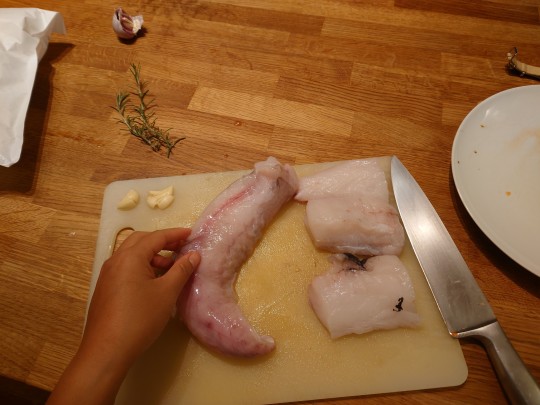


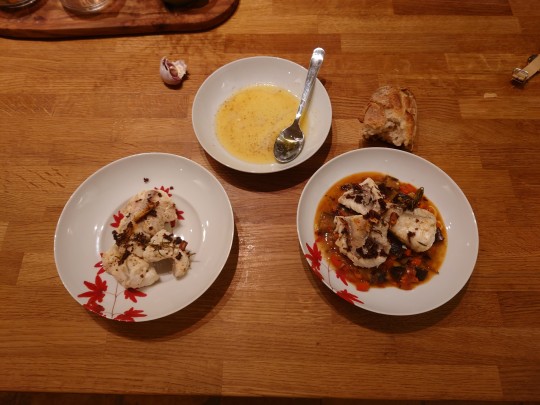
29/08/23
Arrived in France, made ratatouille and monkfish tail (la lotte) in herby butter sauce. One portion for me, with a piece of baguette, and the other portion for Papa who's on the Dukan diet.
4 notes
·
View notes
Text
I LOVE seafood but I've never tried monkfish because hoooooooly expensive batman 🫣 Saw this blessed yellow sticker in Morrisons and decided to give myself a lil treat*

Served it up pan fried in lemon garlic butter with new potatoes, tenderstem broccoli, and homegrown green beans 😋


T'was very tasty indeed! 🤌
...however...
I've never bought full priced monkfish (obviously), and having eaten and enjoyed it I definitely never will.
It was a very nice fish. I'd gladly eat it again. But flavour-wise, it's incredibly similar to something like cod or haddock. The only real difference is the texture which is much firmer and "meatier".
That's not a bad thing at all, it's very nice, but so is the softer flakier white fish options. They're both equally nice in different ways, monkfish just costs way way more.
I suppose one other difference is the lack of fine bones, dude is 100% tail

But yeah, will only ever buy monkfish if I see it reduced which probably won't happen often. Glad I got the chance to try it though 🙂
*I just noticed the date on the pack of monkfish is a week ago, I'm not eating rancid fish I froze this as soon as I got it home 😅
0 notes
Note
hi i just saw that monkfish survey post and didn't see the ''live in the US'' part before i answered 😓 so if you see this feel free to disregard my answers! idk how common they were but i mention monkfish cheeks/tongues and buying directly from fishing boats 😖
You're totally OK. I'll be having an intern sorting through everyone's written-in answers, so I'll tell him to keep an eye out for it.
Tongues, huh? That's a new one! I've heard of the cheeks and livers and whole heads for fish stock, and of course the tail/loins, but yeah, that's new. Cool to hear every bit of the fish is being used. If you live in Asia or Europe, though, we are most likely not talking about the same monkfish! Of you're in Asia, it would be Lophius litulon, and in Europe, you're more likely to be dealing with L. piscatorius. In America, we have L. americanus. 😀 Just some fun facts. Have a great day!
0 notes
Text
Why Everyone Should Eat More Ugly Seafood! In Praise of the Monstrous, Abundant and Delicious Monkfish

Monkfish at the Market
Monkfish are low in calories and fat, packed with vitamins and have dense, firm flesh, which makes them relatively easy to cook. They can be cut into chunks, marinated with egg whites, cornflour and seasonings, then briefly blanched in boiling water. Monkfish tail can even be stir-fried without breaking apart, as more delicate fish tend to do. In fact, there is only one problem with monkfish: they are hideous.
With their bulging eyes and wide mouths lined with rows of sharp teeth, they are nightmarish. In Dutch monkfish are called zeeduivel (“sea-devil”); fishermen who caught them used to throw them back. They are still usually sold without their heads, but the days of chucking them overboard are long gone. Japanese diners love the fatty liver; while Italians may still derisively call them “toad tails”, that does not stop them from eating the fish. Fishermen’s associations have been encouraging others to overcome their aversion and eat more monkfish, as well as other unsightly creatures—the better to ensure more diverse, sustainable fisheries.
There is precedent for species going from shunned to consumed. In America, lobster used to be fed to prisoners and slaves—a result of their abundance but also, no doubt, because they are difficult to eat and look rather like an inflamed cockroach. Not until the late 19th century did they become haute cuisine. Today they are so desirable that Maine, where most American lobsters are caught, puts them on its licence plates (and Monkfish are known as “Poor Man’s Lobster”).
Sometimes fashion goes the other way. Turtles were plentiful in early America, but in the 19th century they became chic: few foods were more esteemed than terrapin turtle soup. Americans ate some species of turtle—fiendishly difficult to prepare, as just looking at them might suggest—nearly to extinction. Yet today turtle-eating is more closely associated with backwoods, eat-what-you-can-catch diets than with liveried waiters.
While abundance and tricky preparation may put some diners off, easily found species that take some work to cook can be delicious. Along America’s north-west coast, advocates tout the versatility of geoduck, a species of burrowing clam with sweet, slightly chewy flesh beneath a thick skin that must be peeled, and an off-putting appearance. Catfish would probably be more popular were it not a bottom-feeder that often resembles a deranged Hercule Poirot. Its clean, neutral flavour makes it suitable for a wide range of cuisines and techniques.
Prizing the rare and beautiful over the unattractive and commonplace is hardly unique to culinary preferences. Engagement rings, after all, usually feature diamonds rather than concrete. But such narrow-minded food choices can have irrevocable consequences: the bluefin tuna and Chinook salmon may not survive human fondness for them. Better to stare into a sea-devil’s beady eyes, or get to grips with a geoduck, than to contribute to the permanent loss of a species. ■
— This article appeared in the Culture section of the print edition under the headline "The Way of the Monkfish" — June 9th 2022
0 notes
Photo
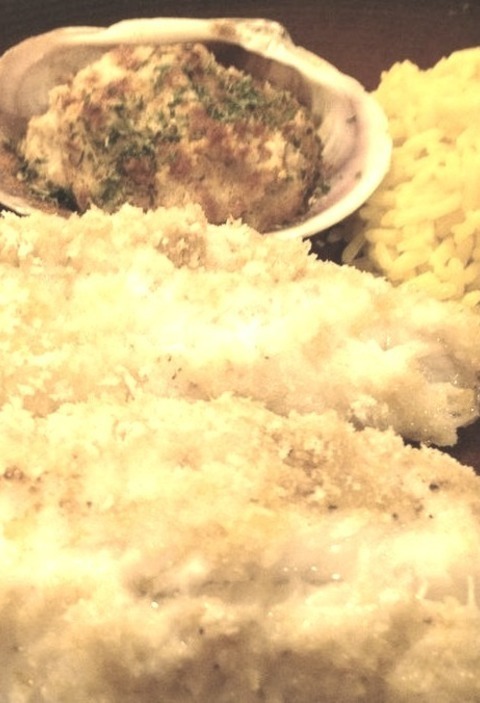
Mock Lobster This is a wonderful and inexpensive dish that may be served in place of the much more expensive lobster tail. 1/4 cup butter melted, 1/2 teaspoon salt, 3/4 teaspoon paprika, 4 tablespoons bread crumbs, 4 fillets monkfish, 1/4 teaspoon ground black pepper
0 notes
Text
Activity 2: Billingsgate Fish Market & Borough Market
Part 1: Billingsgate Fish Market
Grey Mullet is an oily fish and bottom feeder, which can give it a negative reputation of tasting fishy or muddy, but as long as it is fresh it makes an inexpensive and delicious protein. Because of its oiliness, it is more forgiving of being overcooked and it can hold its own against flavourful sauces, just pay attention to its many small bones. Recipe: https://www.greatbritishchefs.com/recipes/pan-fried-grey-mullet-recipe
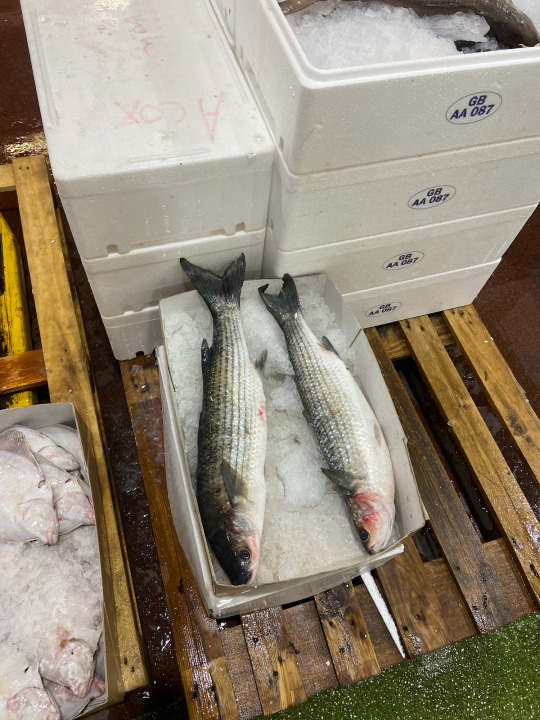
2. Whelks are sea snails that have been a traditionally important food in many seaside European areas. In Britain they are often served boiled, in a vinegar dressing or with butter, as a sort of bar snack, whereas in France and Spain they are typically served with aioli. In both Portugal and Korea they are canned. However, they don’t have to be served plain, they can also be stir fried or battered for something different. Recipe: https://www.lovenorwichfood.co.uk/recipe/sherry-battered-whelks/.
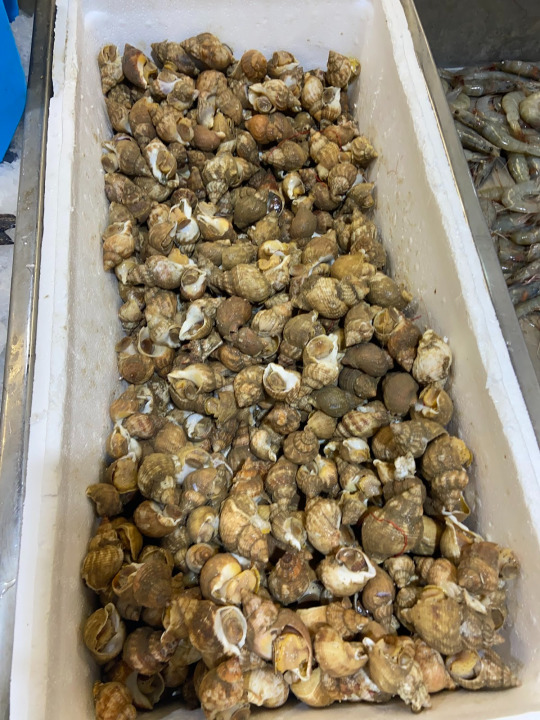
3. Langoustines, Dublin Bay Prawns, or Scampi as they are often called in the UK are small crustaceans in the lobster family. While scampi in North America is typically shrimp in a garlicky white wine-butter sauce served over pasta, scampi in Europe typically refers to the cooked tails of the langoustine in many preparations. Most common on British menus is breaded scampi, usually served with chips and Tartar sauce. Recipe: https://www.bbcgoodfood.com/recipes/scampi-tartare-sauce
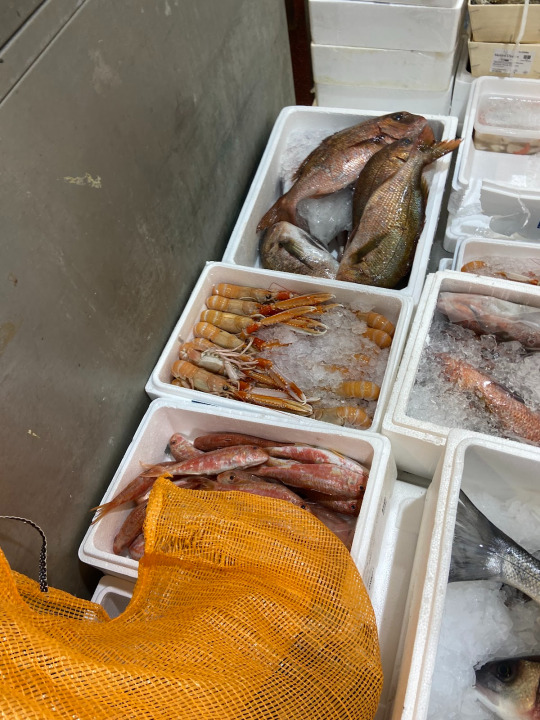
4. Monkfish is a type of anglerfish and has evolved over time from discard to restaurant darling. Its original reputation as a second-rate fish was likely due to its hideous looks, but beneath that frightening exterior hides mild, succulent flesh that has sometimes been called “poor man’s lobster” although the price has risen significantly. In the market it was sold headless, with the skin peeled back to reveal the white flesh of the loins and tail. The boneless fillets are adaptable to a number of cooking styles, but the flavour is delicate and can be masked by strong sauces. The firm texture of the flesh will hold up to methods such as grilling or roasting. In France it is often served in soups, whereas Japanese restaurants, the liver, referred to as ‘ankimo’ is prized, and many are exported from Britain. Recipe: https://www.jamieoliver.com/recipes/fish-recipes/grilled-or-roasted-monkfish-with-black-olive-sauce-and-lemon-mash/
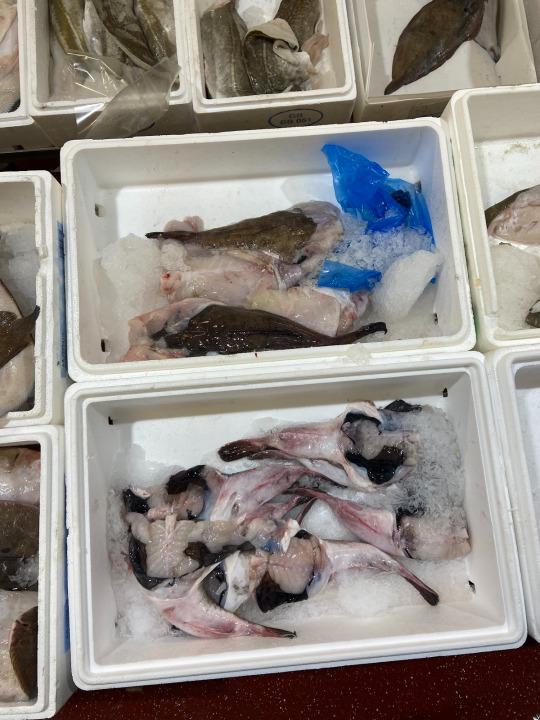
5. Throughout the market we saw displays of cuttlefish cloaked in messy black ink, and one of the highlights of the trip for me was getting to break down a cuttlefish under instruction from CJ Jackson. Cuttlefish is similar to squid in taste and texture, and the ink sacs in its mantle are also highly valued for cooking. Much of the cuttlefish catch is exported to places like Spain and Portugal, but just like squid it is delicious quickly fried, sautéed, or stir fried, or slowly braised. Its neutral flavour makes it adaptable for a variety of cuisines, and both the mantle, cut into strips, and the tentacles can be eaten, though the tentacles are typically slow cooked. One of the most popular preparations for squid and cuttlefish in England is to batter or crumb and fry it, both in the style of the Mediterranean as calamari and Chinese-style salt and pepper squid/cuttlefish. Recipe: https://www.telegraph.co.uk/recipes/0/crispy-fried-salt-and-pepper-cuttlefish-brixham-calamari-recipe/

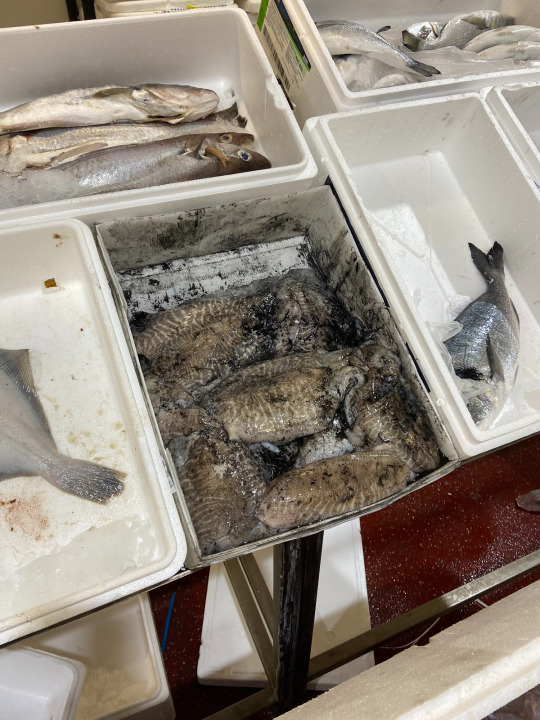
1 note
·
View note
Text
Ooh, what an intriguing matchup indeed! It's good to remember that while most well-known anglerfishes are pelagic deep sea ones, like these,



anglerfishes are just as common in reefs and shallow habitats, and on the ocean floor! Shallow water anglerfishes include frogfishes, batfishes, goosefishes, monkfishes, handfishes... maybe more. They tend to walk on their fins and they don't have such extreme sexual dimorphism as deep sea anglers! I'm not sure if they have bioluminescence outside of the deep sea? What I do know is that they still have lures, which appear like small prey, that they then dangle in front of their faces.






And, well, since I'm already at it, I might as well show the diversity of Tetraodontiformes too! Many of the fish in this order swim via the use of their dorsal and anal fins, which is taken to a big extreme with the ocean sunfishes! They've completely lost their tail fin, and their dorsal and anal fins have become long and muscular like flippers. Mola mola is the most well-known ocean sunfish, but other species exist too.



Like OP mentioned, there's some strangely-shaped Tetraodontiformes, like the boxfishes, pufferfishes and porcupinefishes,



and some more normal-ish fishes, like triggerfishes, spikefishes and filefishes,



and there's also some more peculiar, less-known tetraodontiformes too! Here's a threetooth puffer, Triodon macropterus, the only member of its own family! It has a bellyflap it inflates when it feels threatened! Isn't that cool!!???

Taxonomy Tournament: Fish


Lophiiformes. This order is made up of Anglerfish, which lure in smaller fish prey using their luminescent fin ray. In some species, males are serveral orders of magnitude smaller than the females, which fuse with their mates, reciving nutrients through blood in exchange for sperm.
Tetraodontiformes. This order contains many fishses with unusual body structures, such as boxfishes, which are boxy as the implies, pufferfishes, which are round and able to inflate, and the ocean sunfish, the largest bony fish.
#not me rambling about fish each time#polls#fish#anglerfish#frogfish#batfish#goosefish#monkfish#handfish#pufferfish#porcupinefish#ocean sunfish#boxfish#triggerfish#filefish#spikefish#threetooth puffer#taxonomy tournament
137 notes
·
View notes
Text

Have you seen the 'Blackwater Beast'?
A ‘Blackwater Beast’ has been spotted along the Essex coast with numerous sightings on 31 March.
Over the years, there have been multiple mysterious sightings of strange animals within the Blackwater Estuary. Though some were later discredited, found to be quite ordinary species, others have led to vast speculation. So, what does lurk in the depths surrounding Essex? Maybe it doesn’t lurk at all; perhaps it creeps or even swooshes its way through the water? Might it feast on creatures taking refuge in our underwater seagrass meadows or break the surface and swipe its prey from the land when no one is looking? Is it friend or foe? It seems that the answers to our many questions might just be on the horizon… literally.
A creature coined on Twitter yesterday evening as the ‘Blackwater Beast’ has had two confirmed sightings and one other potential sighting along the estuary in the last 24 hours.
Steve Monahan was the first to spot the beast between the Osea beach huts and Horsey Island yesterday afternoon at about 12:30 pm:
‘I assumed it was just another seal until I noticed that the fins were not seal-like and resembled a fish more than any mammal. It was much bigger than a seal would be. I know the picture is far away, but you can see that it isn’t the right shape for a seal or even a whale really. I have been looking for it on my walks, but I haven’t spotted it since.’

After seeing Steve’s photo, we put a call-out on social media asking if there had been any other sightings of the mysterious creature. We discovered that the beast had been seen from Tollesbury Wick nature reserve at approximately 4:00 pm by Joel Tobison.
Unfortunately, Joel wasn’t quick enough to capture another photo of the creature but did manage to notice something particularly strange:
‘I’m sure it was the same animal in the photo because I remember seeing the tail splash out of the water and then a rounded fin which I thought was curious. It swam in a seal-like motion despite looking more like a porpoise, I was very confused.’
A Maldon local, Fern Richardson, who has lived in the area since birth remembers many previous eye-witness accounts of odd sea creatures which she claims have always turned out to be false:
‘There is always an explanation for this kind of thing. People see something unusual and jump to conclusions.
I was very young at the time but in the 50s there were a couple of horrible, strange looking things wash up on Canvey Island which years later were identified as monkfish but, of course, no one knew what they were back then.’
One of our Landscape Conservation team, Gemma McKenzie, shared her theories of what the truth behind the Blackwater Beast could really be:
‘It’s unlikely to be an undiscovered species although that can never be 100% ruled out. It could be a rare cross between two existing species that has lost its bearings as whales sometimes do. However, the most likely scenario is that it is a large shark, seal or harbour porpoise which has sustained injuries or developed growths on its body which would explain the bumps you can see in the picture.’
Essex Wildlife Trust has stationed local volunteer, James Tedrickson, to the last place the Blackwater Beast was spotted with the hope it will surface again. For now, keep your eyes peeled at the coast and let us know if you see anything fishy.
39 notes
·
View notes